What is Eldritch Blast?
You’ve started a D&D game, and it’s the warlock’s turn. She steadies her focus, and a blast of force energy explodes from her and hits the nearby goblin, sending him backward off a cliff.
She turns to the hobgoblin, and another beam blasts from her and sends the monster crashing into the wall behind it. What D&D spell did she cast to achieve such a powerful effect?
Eldritch Blast is an evocation cantrip on the warlock spell list that throws a beam of energy at a creature and deals force damage from range. It is known to be the core spell for the warlock class as many abilities enhance its potency and utility.

Eldritch Blast has a casting time of 1 action, a range of 120 feet, targets a creature within range and has spellcasting components verbal and somatic. Upon casting, you make a ranged spell attack roll, and if you hit, you deal 1d10 force damage to your target.
Eldritch Blast is a ranged spell attack, which means that any creature within 120 feet can be targeted. However, if your target is within 5 feet of you, you have a disadvantage on the attack roll.
Moreover, the target of the spell must be a creature. This means that, unlike a cantrip like Firebolt, objects cannot be targeted by Eldritch Blast. This includes mundane objects, magical items, and unique objects like an Echo Knight’s echo.
Eldritch Blast requires verbal and somatic components in order to cast. This means that you must be able to speak and have at least one hand free when casting the spell. The spell does not have any material components, which means that you do not need to have a spellcasting focus in hand to cast Eldritch Blast.
Welcome to our Eldritch Blast 5e guide.
At Higher Levels
Eldritch Blast is unique in the way that it scales at higher levels. Cantrips that deal damage scale up when a character reaches 5th, 11th, and 17th levels. This refers to the overall character level and does not require particular class levels.
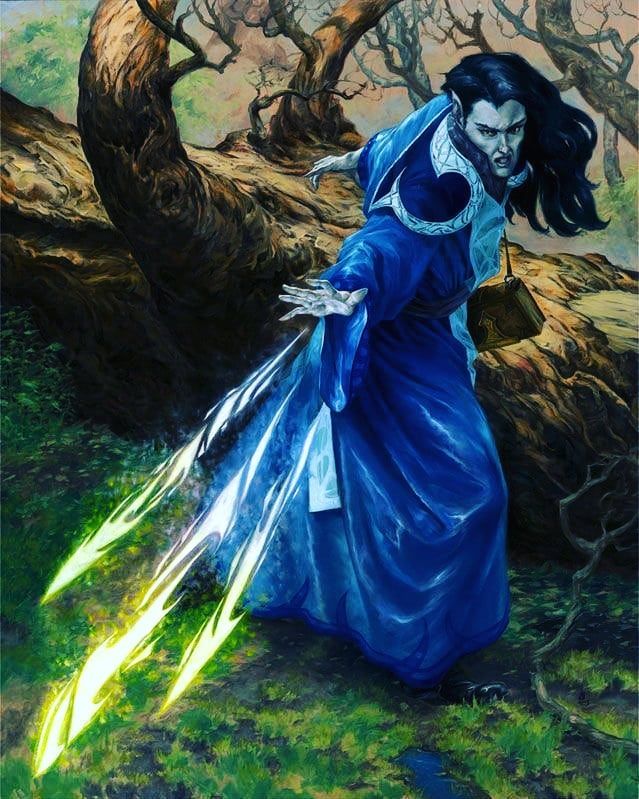
However, most cantrips that deal damage scale by adding additional damage dice to the result of a hit. For example, Firebolt deals scales to deal 2d10 damage at 5th level, 3d10 at 11th level, and 4d10 at 17th level.
Eldritch Blast differs in that instead of a pure damage increase. You can cast multiple beams that can be targeted at different enemies. At 5th level, casting Eldritch Blast produces two beams that each deal 1d10 force damage. At 11th level, you fire three beams, and at 17th level, you fire four beams.
Why is Eldritch Blast Good?
Eldritch Blast is famous for being a powerful cantrip because the rider affects many warlock invocations added to the spell. On its own, Eldritch Blast is comparable to other cantrips like Firebolt and Toll the Dead. Firebolt also deals 1d10 damage and can also target objects.
However, fire damage is very common in D&D. Toll the Dead deals 1d12 necrotic damage, which is both higher damage output and a reliable damage type.
But Eldritch Blast vastly outpaces all of these options once eldritch invocations are added to the equation.
Eldritch Invocations
Eldritch Invocations are special abilities that warlocks gain access to. Some of the most popular invocations are buffs that are added to Eldritch Blast.
Agonizing Blast
Listed first in the Player’s Handbook, this invocation (often called AB or EB+AB online) is almost required if you want to play a warlock. This invocation allows you to add your charisma modifier to the damage of your eldritch blast.
This damage is added per beam of your Eldritch Blast, meaning each beam now deals 1d10 + charisma modifier. At low levels, this boosts your damage from 5.5 to 8.5 and, at a higher level, takes your average damage if you hit four times from 22 to 42.
Repelling Blast
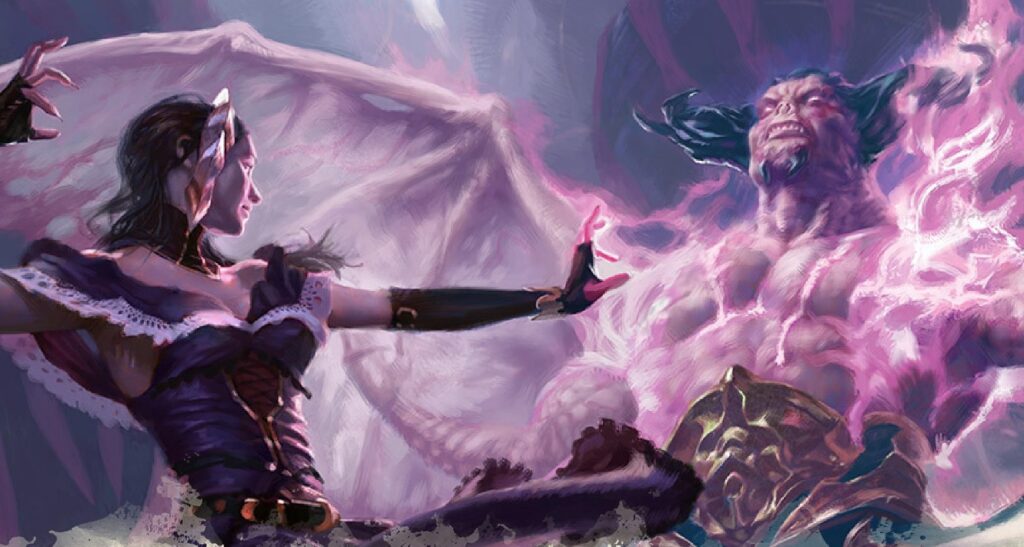
The second eldritch invocation most warlocks like when boosting their Eldritch Blast is Repelling blast (often called RB online). This invocation lets you push a creature backward 10 feet when you hit them with an Eldritch Blast.
Similarly, this effect occurs per beam of your attack. If you hit someone with four Eldritch Blast beams, you can push them backward 40 feet in one turn.
While this ability does not deal any extra damage by itself, forced movement in D&D allows for all sorts of shenanigans. Firstly, if you are fighting on precarious terrain, pushing an enemy backward, 10 feet might send them off a cliff or into lava and immediately end the fight.
Not sure how Lava damage works? Read here to find out.
Secondly, you or another party member might have an ongoing area of effect spells active that will deal extra damage or inflict some condition on your enemy should you push them into it.
Lastly, as a spellcaster, you often don’t want enemies to be anywhere near you. If someone is closing the gap, you can push them back and then run in the opposite direction to keep a safe distance.
While there are other options to force enemy movement in D&D, from the Telekinetic feat to the Crusher feat, Repelling Blast remains one of the best since most of the other options only move a character 5 feet and require a saving throw or have some other restriction like a size difference.
The main limitation of Repelling Blast is that you are forcing your enemy directly backward. This means that you cannot push someone sideways using this ability. It might be difficult to get just the right angle to push someone off a bridge.
This makes your positioning on the battlefield matter much more. It is also important to recognize that forced movement from this invocation and the next do not provoke opportunity attacks.
Grasp of Hadar
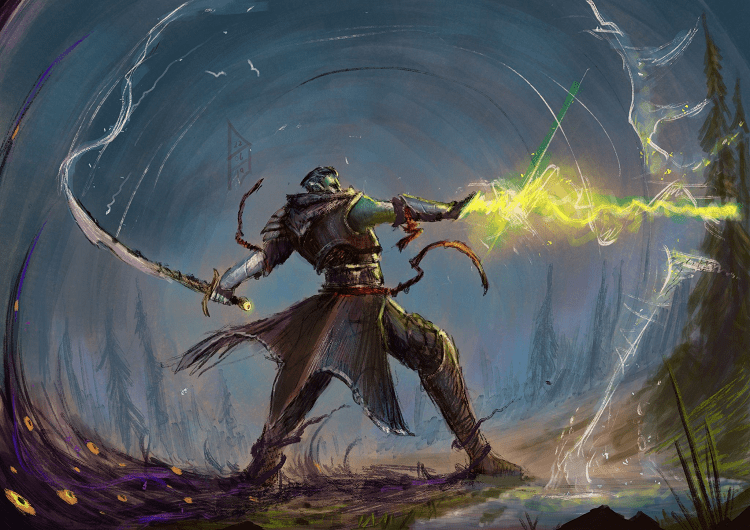
This invocation comes after the previous ones because it is slightly less effective in most circumstances. This invocation lets you move an enemy you hit with an Eldritch Blast 10 feet towards you.
However, you can only do this once on each of your turns. You may have four beams of Eldritch Blast at 17th level, but you can only move someone ten feet towards you once, while Repelling blast can be used for every hit.
Secondly, this invocation is limited to your turn. This means that if you are able to make an attack, not on your turn, you won’t be able to use this invocation. For example, if you ready your action to be cast later in the round, you won’t be able to pull someone with this invocation.
This invocation is still very useful for particular character builds. Like Repelling Blast, this can be used to force enemies into dangerous environmental obstacles or harmful magical effects.
It can also be useful if you want enemies to stay close to you and away from certain allies or objects in the battle. This is less common for warlocks but can be used as a hexblade warlock or durable multiclass builds.
Lastly, this invocation can be combined with Repelling Blast and other forced movement options to push and pull a creature on the same turn. For example, a 5th-level warlock with both Repelling Blast and Grasp of Hadar can fire two beams and move a target a total of 30 feet back and forth.
If they are in the middle of an effect like Spike Growth, they take 30 damage from the movement alone. If you have a druid in your party or you are a Dao genie warlock, this is a powerful combination to grate your enemies to death.
Lance of Lethargy
This invocation lets you reduce the movement of the target of your Eldritch Blast by ten feet once on each of your turns. This speed reduction lasts until the end of your next turn.
Like Grasp of Hadar, this only works on your turn, so if you have War Caster and cast Eldritch Blast as an opportunity attack on someone else’s turn, you cannot reduce their speed. It also only works once on your turn, meaning that you cannot reduce it multiple times using multiple beams.
Like the previous invocations, this lets you control the battlefield. You can use this to keep the enemies inside the harmful effects you’ve pushed them into. It’s also very useful when combined with Repelling Blast to stop enemies from ever getting close to you.
Combine this invocation with a cleric’s Spirit Guardians, a druid’s Plant Growth, and any form of difficult terrains like Spike Growth or Sleet Storm, and your enemies will be forever stuck inside your spell effects with no movement to ever escape while you pick them off from a distance.
Eldritch Spear

This invocation increases the range of your Eldritch Blast from 120 feet to 300 feet. The idea behind this invocation is clear: stay so far away from your enemies that they can’t reach you, but you can always hit them.
While this might be useful in some adventures, the extra range is mostly unnecessary. You should find that most things that you want to hit within 300 feet are also within 120 feet, or you could safely wait until they are before casting the spell.
How to Get Eldritch Blast
There are multiple ways to get access to Eldritch Blast for your D&D character. Since this spell is touted as the most powerful cantrip in the game, many new players do whatever they can to get it.
However, as explored above, its power does not lie in the base cantrip itself but when combined with the powerful rider effects of warlock invocations. Therefore, many of the alternative ways to access Eldritch Blast are tricking you into taking it simply because people say it’s powerful.
Warlock
The easiest and best way to get Eldritch Blast is to take at least one level in the warlock class. While taking one warlock level gives you access to the spell, taking two levels also gives you two invocations to boost its potency.
Since warlocks get their subclass from level one, taking two levels gives you a great number of abilities to go along with it. The most popular option for a multiclass dip is the hexblade warlock because of the ridiculous amount of benefits you gain at level one.
More obviously, if your character is just a warlock, you will have access to Eldritch Blast and will be able to add to it as you level up.
Feats
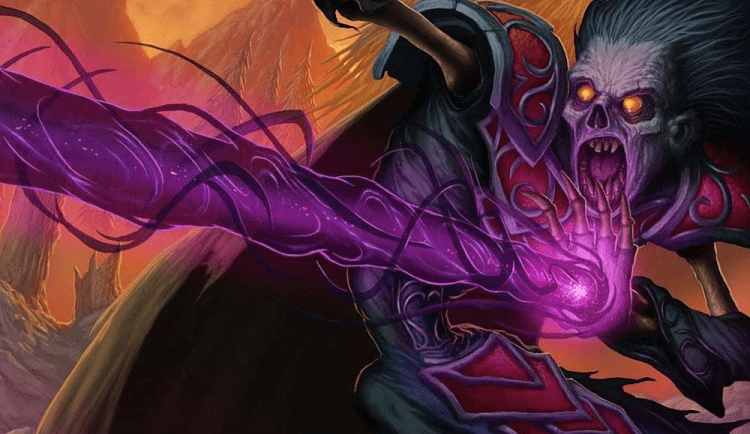
There are a few feats that give you access to Eldritch Blast. However, when you gain the spell in this way, you do not gain any invocations, so it is not as valuable as it may seem.
Spell Sniper
This feat doubles the range for spells that require attack rolls. You ignore half and three-quarters cover for ranged spell attacks, and you gain access to one cantrip that requires an attack roll.
You can pick Eldritch Blast for this feat. However, in order to qualify for this feat, you need to be able to cast at least one spell. If you want to play a fighter that can pick up this feat, there are many race options that can cast at least one spell so that you can qualify.
Magic Initiate
This spell gains you access to two cantrips from the same spell list. In this case, you would choose warlock and Eldritch Blast. You also gain one 1st-level spell that you can cast once a day.
Best Feats for Eldritch Blast
While the previous feats help you gain access to this spell, the following feats combine well with Eldritch Blast to make some fun options for your build.
War Caster
This feat gives you advantage on Constitution saving throws to maintain concentration on your spells. You can cast spells even with your hands full, and, most importantly, you can cast a spell as a reaction when an enemy provokes an opportunity attack.
With this feat, you can blast someone with up to four beams should they provoke an opportunity attack from you. With Repelling Blast, this lets you blast someone up to 40 feet backward as a reaction.
Polearm Master
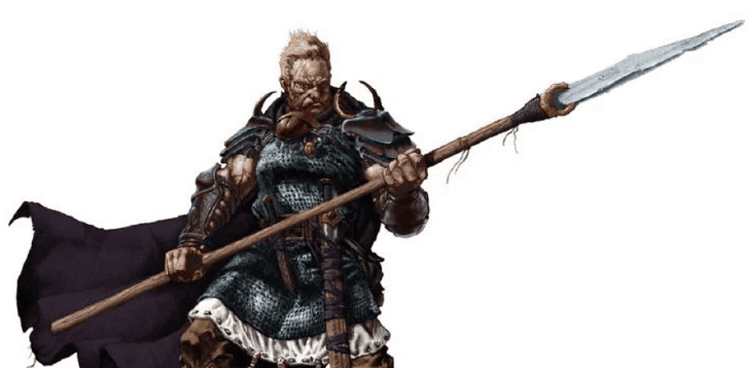
While you may think this feat is only useful on melee-focused builds, this feat, when combined with War Caster, creates an interesting situation. With this feat, enemies provoke opportunity attacks from you when they enter the reach you have with a polearm weapon.
However, the opportunity attack that you take does not have to be with that weapon. War Caster allows you to cast a spell instead of making an opportunity attack.
The combined effect is that an enemy can enter your 10-foot reach and trigger an opportunity attack, which you can then use to cast Eldritch Blast. Depending on your invocations, you can knock them back, slow them down, deal incredible damage, and most likely stop them from getting close to you.
Metamagic Adept
If you love Eldritch Blast so much, you can pick up this feat and take Quickened Spell. Once per day, you can cast Eldritch Blast as a bonus action and then follow it up by casting Eldritch Blast as an action.
Eldritch Adept
It’s hard to fit all the invocations that you want into your build. Pick up this feat, and you gain an additional invocation to stack more powers onto your Eldritch Blast.
FAQs
Question: What is an Eldritch Blast?
Answer: Eldritch Blast is a cantrip on the warlock spell list that hurls a beam of energy at a creature and deals 1d10 force damage. At higher levels, the spell produces multiple beams and has additional rider effects that can be added to it.
Question: What is so Great about Eldritch Blast?
Answer: Eldritch Blast is great because there are multiple effects that can be stacked on top of it from the warlock invocation list. These effects increase the damage greater than any other cantrip and allow for great control options on the battlefield.
Question: How do You Maximize Eldritch Blast?
Answer: Take at least two levels in warlock so that you can add the Agonizing Blast and Repelling Blast invocations. Cast hex on your target and aim to combine casting Eldritch Blast with area of effect spells like Spike Growth to push enemies into harm’s way.
Question: Is Eldritch Blast Noisy?
Answer: Eldritch Blast makes a sound. The spell has verbal components, meaning you must speak out loud in order to cast it. The spell also describes the beams created as crackling energy, which most likely makes a sound.
Question: Can You Cast Eldritch Blast twice?
Answer: Yes, if you have access to the Quickened Spell metamagic or the Illusionist’s Bracers, you can cast Eldritch Blast as a bonus action and then cast it again as an action. With the War Caster feat, you can cast it as a reaction as well.
Question: Is Eldritch Blast Lightning?
Answer: No. While the spell description sounds similar to lightning, the beams created by the spell are pure force energy. Furthermore, the spell deals force damage and not lightning damage.
Question: Does Eldritch Blast Need Sight?
Answer: No. The spell does not specify that you need to see the target in order to hit them. However, if you target a creature you cannot see, you will have disadvantage on the attack roll.
If you target where you think they are, but they aren’t there, the attack will miss even if you roll high enough to hit their AC. Furthermore, if they are behind a wall or other barrier, they may have total cover from your attack.
Question: Can You Hex and Eldritch Blast?
Answer: Yes. This is one of the most common and powerful combinations for warlocks at low levels.
Question: Do Eldritch Knights Get Eldritch Blast?
Answer: No. Despite the similarity in title, Eldritch Knights get access to the wizard spell list while Eldritch Blast is on the warlock spell list.
Summary
Eldritch Blast is one of the most powerful cantrips in D&D 5e. It allows you to shoot a beam of pure energy at a target within 120 feet and deals force damage, which is the least commonly resisted damage in the game.
Moreover, as the spell scales with your level, it produces multiple beams of energy that can be targeted at the same creature or various others.
With powerful rider effects like forced or slowed movement, Eldritch Blast allows a warlock to control the battlefield, pushing and pulling enemies into and out of position.
Without the eldritch invocations to boost the spell, Eldritch Blast is not as powerful as it may be considered. If you’re interested in maximizing this spell, combine it with invocations and area of effect spells to deal extra damage and to stop enemies from getting where they want to go.
- Armor of Agathys 5e Guide: What is Armor of Agathys? - August 3, 2022
- Oath of the Ancients 5e Guide - August 3, 2022
- Dissonant Whispers 5e Guide - July 20, 2022

